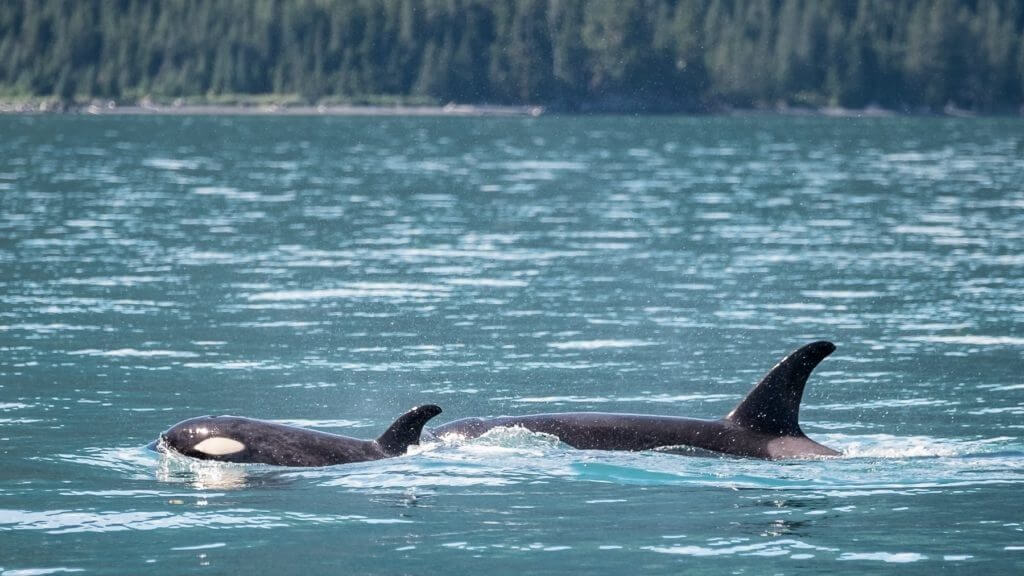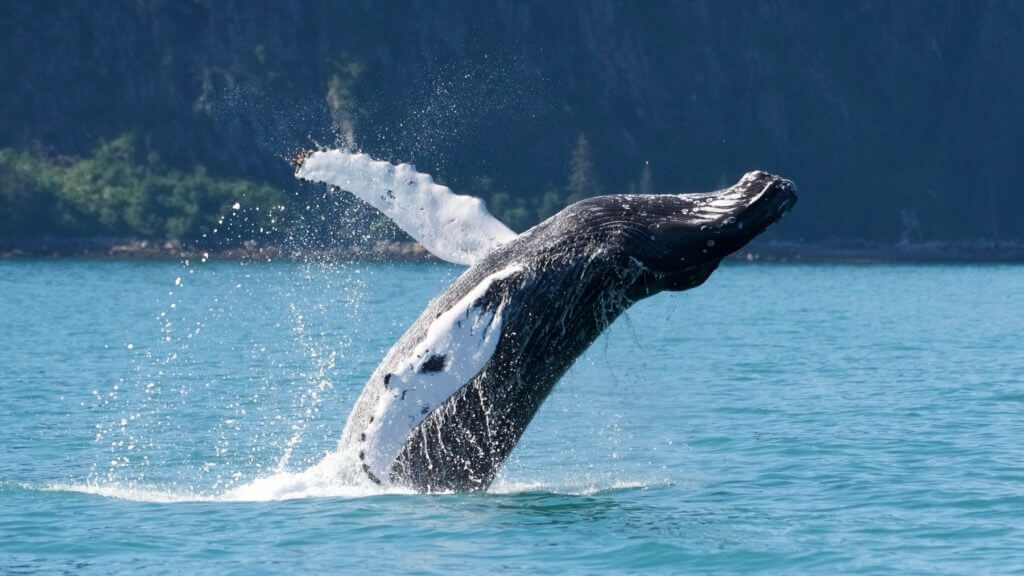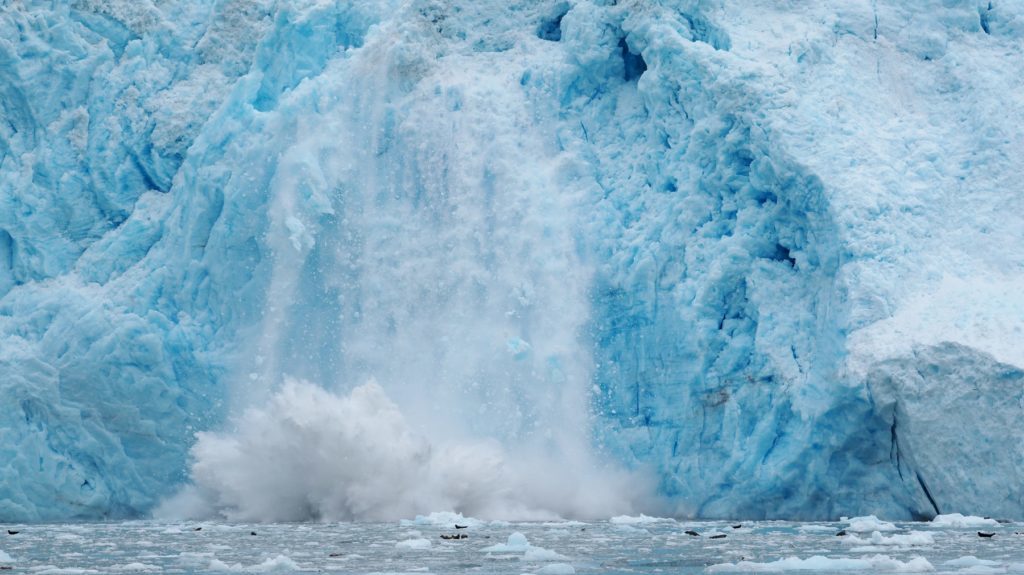Tamara Lang, Major Marine Tours deckhand and interpretive volunteer at Kenai Fjords National Park, recounts her favorite memories from a season spent on the water in Kenai Fjords National Park.
As August brings Alaskan fall, and the pink stalks of fireweed that measure the summer clutch their final blossoms, my season at Major Marine Tours also draws to a close. With a few precious weeks left on the Kenai Fjords, I look into the waters and see reflected the white mist tearing off of ridges silhouetted with dark spruce, and above the changing water my mind moves back to my most treasured moments of the season onboard Major Marine vessels.
1. Orca Calf Nursing
I’ve written in past posts about how it was the orca that led me to Alaska this summer, and so past readers will already be familiar with that visceral chill of watching an orca fin rise from rippled water for the first time. But orca move with such intelligence that they cannot be seen once and checked off of a list — they are different every moment, responding to the environment of that instant in ways that surpass my prediction. Viewing orca comes not as a photo backdrop, but a relationship, and every time they move beneath the bow I settle into the feeling of being humbled by the chance to move alongside such intelligent animals.
But then there are moments when the orca move aside and show you a truly special glimpse into their lives — the resident (fish-eating) bull orca rising with a king salmon gripped in his teeth. The slow slide of transient (marine mammal-eating) orca beneath Aialik glacier, keeping pace with the Spirit of Adventure as we moved between them and the oblivious harbor seals resting on calved glacier ice.
But one moment with the orca pierced through the water’s surface and into my very core, as I stood on the stern of the Spirit of Adventure behind a row of passengers awed at the orca’s simple presence. In our four o’clock position a calf nosed the surface beside its mother, who slid behind to nudge him in the direction of the boat. Together they swam towards us, their motions as silken as the smooth water. Just as they reached the point where my eyes could reach through the water the cow turned slowly on her back, her belly a white puzzle beneath the clear water, and as they slid beneath our stern the calf moved forward to nurse. Beneath our eyes they came together in a pattern of white shadows, wild even in this softest moment, as we watched the bond that would structure the entire existence of the growing calf as he grew to learn the ways of his maternal pod.
Watching the orca pair was not a right — it was a gift, a moment shared between two animals of vast intelligence and emotion, given to those of us onboard who sat within our own emotions and intellect. And it was not only sight I felt, but relationship.

2. Breaching Humpback
When a humpback breaches, the world stands still. Sound grows thick as the body of the whale hovers weightless as the top of her jump, our ears stretching toward the moment when her body falls into the flat of the sea and eclipses her in white wings of spray. The boom that follows echoes cavernously through my chest. And then she dips down, rises to send a column of breath skyward once, twice, and as her fluke rises the sea moves flat and empty once more as we search for the place where she will erupt from the water one more time.
Do it again, do it again — this is the rhythm of want that beats through those of us on the boat, the whale’s body playing our senses like a drum. Do it again, do it again. Beneath the sun-soaked cliffs beside No Name Island, our minds beg her, do it again. Against the backdrop of a glacier that sits forgotten for the whale beneath, we breathe, do it again. Every time a blow rises, every time a fluke drops, our minds pound out the same rhythm: do it again.
There is no single moment beside a breaching humpback that I can claim, but simply the power of that rhythm pounding throughout the summer.

3. Calving of Aialik Glacier
At times I think I am used to the glaciers calving. At times I think, I would rather stay inside and bus tables than brace the cold katabatic winds that carry the ice’s breath. At times I think that today might be the day the glacier becomes ordinary.
But then I step outside. And I am wrapped once more into the deep blue of the ice that is unlike any other color nature brings, caught upon the erratic beauty of jagged seracs, pressed within the color of crevasses, held within each roar of ice that pulls my eyes to catch the calving.
And it is in these times that I brave the cold that the glacier speaks back. Two days ago, light rain fell at an angle. My fingers felt numb from holding the ice I had brought out of the sea with a salmon net. I pondered hot chocolate for the ride back. But then I looked heard a stir upon the bow and looked up to see a sheet of ice collapsing noiselessly to meet the water with a resounding crash, and as I stood in awe another piece splashed down, and then as I watched in stricken silence an entire sixth of the glacier broke loose and slid into water that caught it with a belated clap of thunder that smacked our ears and left us loose with wonder. I watched the waves curl outward, lifting the ice as Captain John gently moved our stern toward the oncoming waves. “Hold on guys — we’ll try some glacier surfing,” I smiled to those on the bow, giddy with the sight. The brown waves came long and low and gentle, rolling through our boat to pass on throughout the bay. And as I stood there, struck by the softness of such a violent process, the glacier rocked me with the realization that such a stunning process could never become ordinary.

With orca, humpback, and glaciers frozen in memory, it will be hard to leave Seward, even though the southern hemisphere beckons. But I have the next several weeks to make new memories onboard the boats, and the glaciers look bluer now than they ever have before. The mountains wear autumn well.
I will leave for California as the gray whales move through Alaska on the same journey, and throughout the fall Major Marine boats will be there to greet them as they move southward. And when the gray whales return next spring, I will be standing on the bow to welcome us both back home to Alaska.
And then the sea and I will make new memories together.
Tamara Lang is a deckhand with Major Marine Tours and a writer currently at work on a project called Glacier Margaritas, which take one year to explore climate change in the here-and-now of Alaska’s Kenai Fjords and Australia’s Great Barrier Reef. Read more of her work at tamaralang.com, or follow her on facebook and instagram at tamaralangwrites.
Signup for our newsletter to get the most recent Major Marine updates.